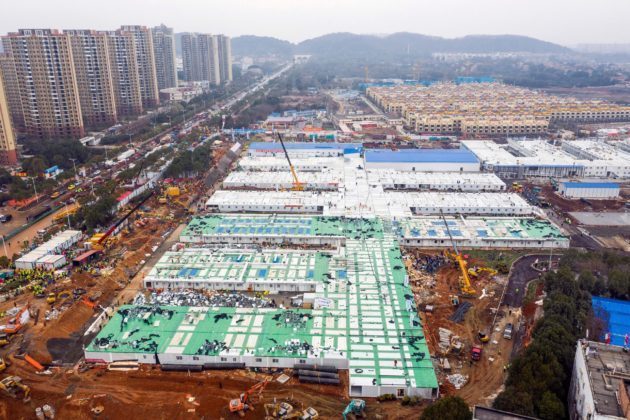
China opens 1,000 bed hospital built in under 2 weeks to relieve hospitals swarmed with patients of deadly coronavirus/COURTESY
BEIJING, China, Feb 4 – Coronavirus patients arrived Tuesday at a Chinese field hospital built from scratch in under two weeks at the frontline of the outbreak, state media said, following a round-the-clock construction marathon that became a national social media sensation.
The 1,000-bed facility was built to relieve hospitals swamped with patients in Wuhan, the city in Hubei province at the epicentre of the national health emergency that has killed more in China than the 2003 SARS outbreak.
Fifty patients arrived at the military-run facility, the state-backed China Daily reported, with images showing workers in protective suits pushing people in wheelchairs up a ramp and into the pre-fabricated structure.
The virus has killed more than 400 people and infected a further 20,000, nearly all of them in Hubei, and spread to two-dozen countries since it emerged in December at a market that sold wild animals in the city.
The World Health Organization has declared the crisis a global health emergency, and the first death outside China was confirmed in the Philippines on Sunday.
As reports surfaced of bed shortages in hospitals in Wuhan, construction began on Huoshenshan — “Fire God Mountain” in Chinese — on Friday January 24.
Workers toiled day and night amid a forest of earthmovers and trucks carting materials around the site, southwest of the centre of the city of 11 million.
On the side of one of the trucks, the isolated city’s new rallying cry — “Let’s go Wuhan!” — was written on a banner.
– Fire and thunder –
All workers wore masks, as mandated by the authorities for the entire population of Wuhan, and were checked for fevers during their breaks.
By the following Friday, they had laid 400 prefabricated shipping-container-like rooms, after setting concrete foundations and routing the power supply to the complex.
The two-floor facility was handed over to the army on Sunday and will be staffed with 1,400 military medics, including some with experience dealing with SARS and Ebola.
State media had initially reported that patients would begin arriving Monday — inside the 10-day timeframe authorities had set out when construction began.
Leishenshan (“Thunder God Mountain”), another hospital on an adjacent site, is set to start admitting patients on Thursday, with 1,600 beds.
Fire and thunder are traditionally associated in China with protection against illnesses.
Authorities said the Wuhan facilities were modelled on the Xiaotangshan hospital in Beijing, which was built from prefabricated structures in barely a week to treat patients infected by SARS in 2003.
That pathogen killed 349 people in China and hundreds more in Hong Kong and abroad.
However, with the death toll surging in Wuhan and elsewhere in Hubei province, it was not immediately clear what overall impact the hospitals would have on the virus spreading elsewhere.
The city also plans to convert three existing venues, including a gymnasium and an exhibition centre, into hospitals, the Wuhan government said.
The three buildings will be turned into healthcare facilities with a total of 3,400 beds to take in patients with mild symptoms.
– Livestreamed –
Footage of the mammoth construction effort was livestreamed continuously on social media and watched tens of millions of times.
It has also been feted endlessly in state media as an example of the decisive response to the public health crisis after authorities in Hubei faced a torrent of public anger for perceived incompetence, including delays in announcing the public health emergency.
Local Communist Party secretary Ma Guoqiang acknowledged Friday that officials had worsened the spread of the virus by failing to restrict travel earlier.
When a lockdown and blanket travel ban were finally introduced, they swept up more than 50 million people in Wuhan and nearby cities.



































